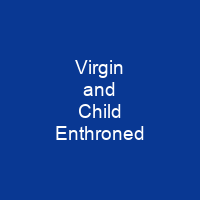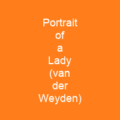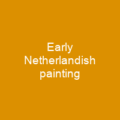The Virgin and Child Enthroned: A Masterpiece of Early Netherlandish Art
Imagine stepping into a world where every brushstroke tells a story, every detail holds a secret, and every color dances with the light. The Virgin and Child Enthroned (Thyssen Madonna), painted around 1433 by Rogier van der Weyden, is such a masterpiece. It’s like entering a small, intricately designed room filled with whispers of history and spirituality.
Iconography and Symbolism
The painting is rich in symbolism and iconographic elements, much like a treasure chest waiting to be opened. The Virgin Mary sits on an elaborate throne, her presence both maternal and regal. Christ, dressed in red, rests on her lap, his innocence and divinity palpable. But what makes this painting truly special are the details that hint at deeper meanings.
Take a closer look at the iris growing to the side of the aedicula—this flower symbolizes Mary’s sorrow over Christ’s Passion. On the other side, a columbine recalls the Sorrows of the Virgin, adding layers of emotion and narrative depth.
The lintel above them is adorned with six reliefs from the New Testament, depicting scenes from the Life of the Virgin. These stories are like windows into the past, each one telling a part of the larger narrative that surrounds the central figures.
Artistic Influences and Techniques
The Virgin and Child Enthroned is not just a painting; it’s a fusion of influences. Van der Weyden’s style reflects his apprenticeship under Robert Campin, with the panel filled with details reminiscent of Jan van Eyck’s work. The use of grisaille, or monochrome painting, distinguishes between the earthly realm and the divine, creating a stark contrast that adds to the painting’s spiritual intensity.
The arrangement of sculptural elements may have been influenced by Claus Sluter’s Well of Moses, which shares a similar alignment. This connection suggests that van der Weyden was not just an artist but also a master storyteller, weaving together different artistic traditions to create something uniquely his own.
The Painting’s Place in Art History
Art historians have debated the exact place of this painting within van der Weyden’s oeuvre. Some suggest it might be part of a diptych or double-sided panel, with the Washington Saint George and the Dragon as its likely opposite wing. Others believe it stands alone, showcasing how van der Weyden juxtaposed the otherworldly realm of the Madonna and Child with the earthly setting and contemporary dress of the saints.
The painting shares similarities with Robert Campin’s Virgin and Child before a Firescreen, including facial features, hair style, pose, color, and clothing. This connection highlights van der Weyden’s deep understanding of his predecessors’ work and his ability to innovate within the constraints of tradition.
While some attribute the work to van der Weyden’s workshop, others credit it directly to him or even to Campin himself. Regardless of its exact provenance, the painting is a testament to the early stages of van der Weyden’s career and his transition from apprenticeship to master artist.
Conclusion
The Virgin and Child Enthroned (Thyssen Madonna) is more than just a painting; it’s a portal into the past, a window into the complex world of early Netherlandish art. Each detail, each symbol, tells a story that resonates through time. As you gaze upon this masterpiece, can you hear the whispers of history and see the light of divine presence? The Virgin and Child Enthroned is not just a painting; it’s a journey into the heart of Christian iconography.

You want to know more about Virgin and Child Enthroned?
This page is based on the article Virgin and Child Enthroned published in Wikipedia (retrieved on November 29, 2024) and was automatically summarized using artificial intelligence.







